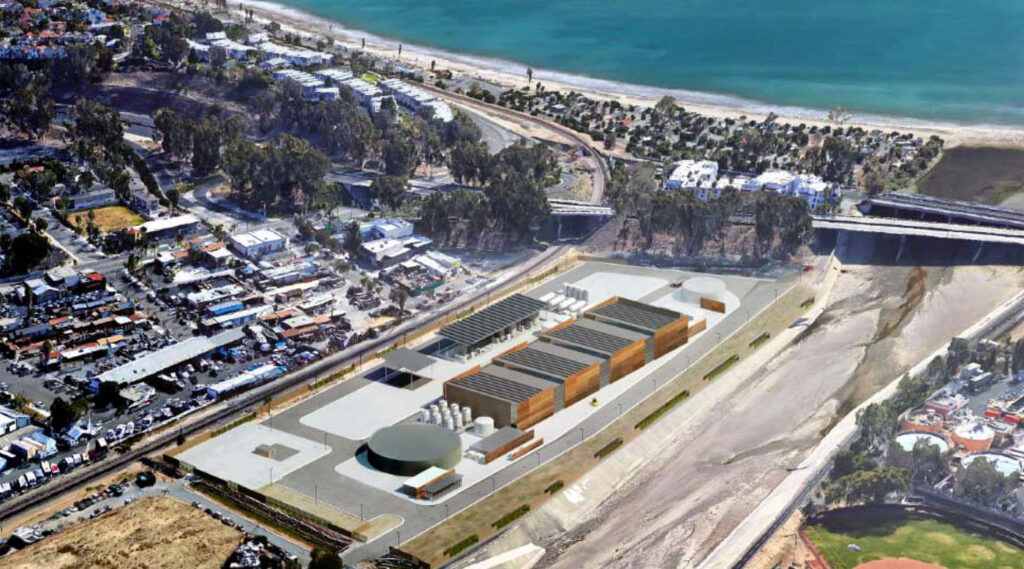
A desalination plant proposed near Doheny State Beach was unanimously approved Wednesday, March 9, for the first of three necessary state permits, sailing through the San Diego Regional Water Control Board hearing in three hours with no major concerns raised by either the board or the public.
That’s a sharp contrast to the regulatory scrutiny — and extensive public opposition — for Poseidon Water’s much larger desalination proposal up the coast in Huntington Beach, reflecting numerous differences between the two plans.
Wednesday’s approval could signal a smooth regulatory path ahead for the Doheny project, proposed South Coast Water District. But the small district continues to seek financial partners among neighboring water agencies — and beyond — in order to bring down customer costs.
South Coast President Rick Erkeneff said after Wednesday’s approval that his district’s staff has begun extensive meetings with potential partners now that there are firm cost estimates and that regulatory approvals are being lined up.
“We didn’t want to be prematurely out in the community before we had the price and the permits,” Erkeneff said. “Now, we’re shifting to where we’ve got our price, and we’re getting our permits. We’re getting the (proposed) agreements together that we can present to potential partners.”
He said he was “100%” confident that those partnerships could be reached.
A cost analysis last summer found that with partners, the district could build a $126 million plant producing 5 million gallons of potable water daily — enough for more than 35,000 people — and that the project would cost the average household $2.38 more a month. Going it alone, the district would build a $71 million plant producing 2 million gallons a day, with an average monthly increase of $7.20 per household.
The larger plant also would have the ability to expand to 15 million gallons daily if more neighboring agencies wanted to buy in.
Water vulnerability
The district — like most of south Orange County — relies on water imported from the Colorado River and northern California for 90% to 100% of its supply, with very little groundwater aquifer storage to hold local water. That leaves the region particularly vulnerable to drought-related reductions in imported water, and to earthquakes, as the import pipelines cross five faults in Orange County alone.
That’s one of the big differences between the Doheny and Huntington Beach desalination projects. Poseidon would serve the north and central portions of the county, where a vast groundwater aquifer stores storm water and Santa Ana River flows, as well as purified flows from the nation’s largest recycled wastewater operation. In all, less than a quarter of the water used by households in north and central Orange County is imported.
The Municipal Water District of Orange County ranked the Poseidon project low in a 2018 study of proposed projects throughout the county, finding it would obligate participating agencies to buy far more water than needed and would cost more. While the Municipal Water District has remained officially neutral on the Huntington Beach plan, the district wrote an enthusiastic letter of support for the Doheny proposal.
Environmentalists also have taken a more welcoming view of the Doheny project. One of Poseidon’s most ardent opponents, Orange County Coastkeeper, wrote a letter of support for the Doheny plan while the Surfrider Foundation has opposed Poseidon while remaining neutral on Doheny.
The Doheny proposal is in line with the state’s Ocean Plan, which prefers that ocean water for desalination be taken in through pipes submerged under the sand rather than sucking it directly from the ocean. The subsurface intake process virtually eliminates marine life mortality, but Poseidon consultants have determined that such technology isn’t feasible at the Huntington Beach site.
Another difference is that Poseidon is a private, for-profit enterprise, while Doheny is being led by a public agency.
Poseidon needs one final permit, from the state Coastal Commission, and could have a hearing for it in May. South Coast Water District needs approvals from the Coastal Commission and the state Lands Commission, both of which it hopes to obtain by the fall.
Potential partners
While none of the 10 public speakers at Wednesday’s meeting opposed the Doheny plant, two questioned why the 7.4 acres of environmental mitigation was proposed for the Los Cerritos Wetlands north of Seal Beach, where a conceptual restoration plan is well underway. Those speakers wanted the environmental work focused in the Doheny area, although a clear plan for such work has yet to emerge.
Meanwhile, Rick Shintaku, general manager of the South Coast Water District, said he’s had productive partnership meetings with the city of San Clemente and with the Laguna Beach County Water District. He said he anticipates additional conversations with the Santa Margarita Water District and the Moulton Niguel Water District.
Related links
New cost study could jump start Doheny desalination project
Key hearing on Poseidon desalination plant delayed two months
Tale of three desalination plants: Why the Doheny proposal is winning over some skeptics
Poseidon wins key permit for desalination plant in Huntington Beach
Orange County water study updated, Poseidon desalination plant still scores low
He’s also talked with the Eastern Municipal Water District in Riverside County about a “paper transfer” — an agreement where the Inland Empire district would buy imported water rights from South Coast and Shintaku’s district could use the money to help cover desalination costs.
Additionally, Shintaku said he recently hosted a related visit from Adel Hagekhalil, general manager of the Metropolitan Water District of Southern California, which coordinates imported water throughout a six-county area.
While Shintaku declined to discuss specifics of the meeting, he called it “important.”
“There’s a variety of potential partnership possibilities,” he said
